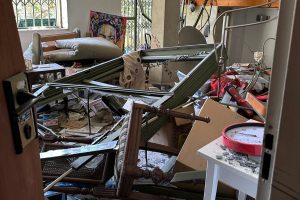MONTREAL — Paul Herczeg, Tommy Strasser and Teddy Bolgar all adamantly insist they are 78 years old.
At least that’s the age they would be if they were really under 18 when they arrived in Canada 60 years ago as Jewish war orphans.
As the three indicated in a recent interview, not all immigrants were necessarily under that 18-year age limit, which was a condition to get a much-desired visa to Canada for teens and children who were not killed in the Nazi camps.
The three friends were among some 30 survivors and their families who met Oct. 26 in the party room of a Cote St. Luc apartment building to celebrate the fact that they had not only survived in Canada, but prevailed for six decades after the government allowed in 1,123 Jewish war orphans, the vast majority from Hungary. Fewer than 40 were under 10 years old.
They were let in because Canadian Jewish Congress and other Jewish agencies, including Jewish Immigrant Aid Services (JIAS), had lobbied hard for it. And the Canadian government, with its lamentable legacy of being the country of “none is too many,” reluctantly agreed to the deal, while insisting that the Jewish community pick up the entire cost of housing, feeding and finding jobs for the young newcomers.
In an interview with The CJN, the three friends said the informal gathering – the last anniversary event was the 50th – was marked by joy and laughter, and a genuine appreciation of the lives they have lived here.
“There was incredible happiness” at the event, said Herczeg, a retired importer-exporter who landed at Pier 21 in Halifax in January 1948.
Also arriving at Halifax Harbour a little later was Bolgar.
He and Herczeg had both been slave labourers in a satellite camp of the Dachau concentration camp in Mühldorf, Germany, but they didn’t know each other during that time.
Strasser, who had a varied, colourful career in Montreal as a wholesaler and retailer and in real estate, had himself been part of a forced labour battalion. His life was saved by Swedish diplomat Raoul Wallenberg.
“He saved us on a death march from Budapest to Vienna,” Strasser said. “He was able to make a deal to send those who were under age 18 and over age 60 back to the ghetto in Budapest.”
Life in Canada for the three men was, not surprisingly, a considerable improvement over the immense suffering they and all the other orphans had endured in camps, in ghettos or in hiding. More than half of Hungary’s 800,000 Jews perished in Auschwitz.
Herczeg, who was from Ujpest just outside Budapest, lost his sister and mother in Auschwitz, along with dozens of extended family members, while his father died in the Mühldorf camp.
Strasser, an only child, was from a town in Slovakia, about 90 kilometres from Budapest, whose 4,000 Jews were almost all exterminated at Auschwitz, including his parents and other family members.
Like other Europeans trying to avoid the Soviets in Europe after liberation, he went to Paris, where he lived for a few years and learned he could apply to go to Canada with the help of Congress.
“I didn’t want to be in Europe anymore,” Strasser said.
Bolgar, who was from a town called Sarosbatak, lost his sister and mother in Auschwitz. His father, who survived, decided to remain in Hungary, where he died in 1957.
Bolgar and Herczeg were liberated in May 1945 in Munich. Each learned of the possibility that orphans under 18 could come to Canada, and applied.
“The irony,” Bolgar said, “is that if Israel had existed at that time, I would have gone there.”
In Montreal, where about one-third of the orphans settled – most of the others came to Toronto, with small numbers going to Saskatchewan, Alberta and Manitoba – the Jewish community rallied to help them. They slept at the Baron de Hirsch Institute’s Herzl Family Clinic at 4650 Jeanne Mance St. and were taken to the landmark Joe Schreter’s clothing store on the Main. JIAS gave them aptitude tests and they got free membership at the YM-YWHA.
Some of the orphans who came to Canada later became well known, including theatre director John Hirsch, painter Maxwell Smart and wrestlers George Reinitz and Nick Sebastien.
“We came with nothing,” Herczeg recalled, noting he arrived with a sense of both elation and fear. “I came in January 1948, and went into the city, and froze my butt off!”
Jobs were found for all the orphans. Herczeg worked in a suit factory, while Bolgar got work as an electrician, even though his background was as a lady’s handbag maker.
“We all jumped around a lot,” Herczeg said. All eventually married and raised their own families.
They are fully aware that they didn’t survive the war and have the opportunity to live full lives here because they were smarter or stronger or wilier.
“We were just lucky,” Strasser said.






